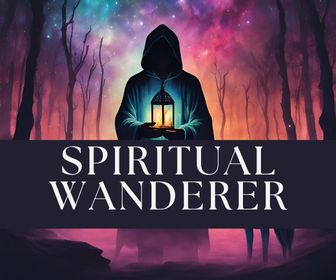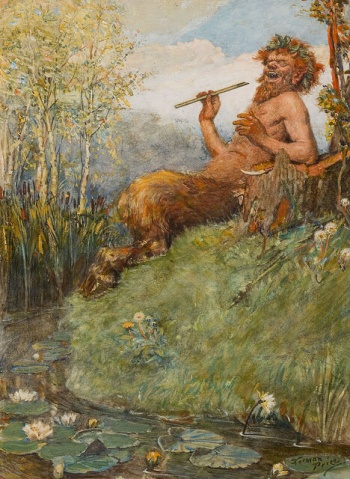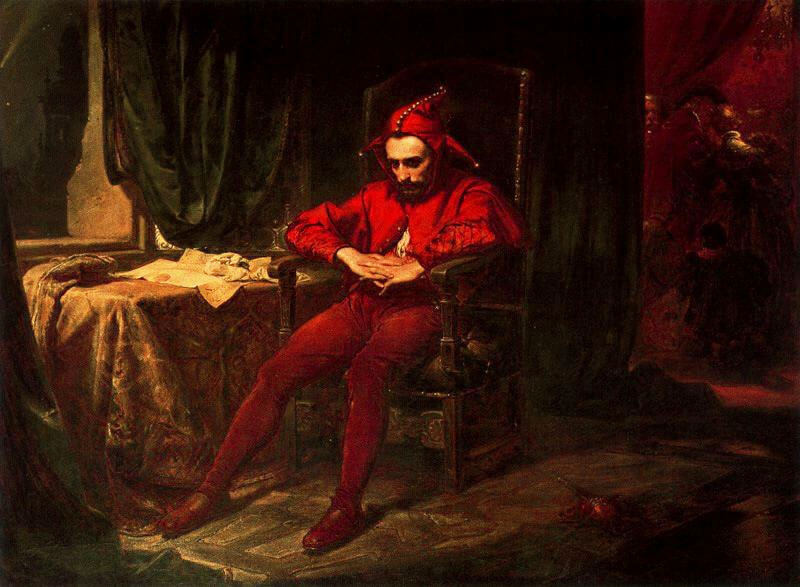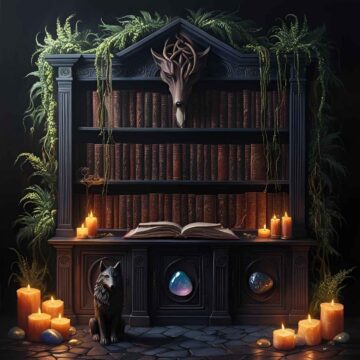Trickster is at one and the same time creator and destroyer, giver and negator, he who dupes others, and who is always duped himself … He knows neither good nor evil yet he is responsible for both. He possesses no values, moral or social, is at the mercy of his passions and appetites, yet through his actions all values come into being. ~ Paul Radin
When Trickster archetypes prance and prank their way into your life, it’s time to pay attention!
Tricksters defy duality: they are both light and dark, heroic and villainous, foolish and wise, benign and malicious. At the same time they’re lovable, they’re also hateful. At the same time they’re friendly, they’re also fearsome. If you feel drawn to, or repulsed by, the Trickster archetype, this is a clear sign that you need to explore the hidden parts of your nature more.
In mythology, Tricksters are portrayed as the jokers, pranksters, clowns, rule-breakers, alchemists, magicians, truth-tellers and wise-fools. In psychology, Tricksters are the mischievous archetypes of the collective unconscious that shatter old paradigms and gleefully poke sticks at our sanctimonious beliefs and stiff pretensions.

Spiritual Wanderer Course:
Being a lone wolf and a spiritual wanderer is a sacred calling in life – a unique and alchemical path of awakening. You don’t need to feel lost, alone, or stuck on your journey any more. It’s time to meet your soul’s deep needs for clarity, self-acceptance, and empowerment. Let us show you how …
These days, Trickster archetypes still appear in our cultural myths and dialogues. Tricksters continue to incarnate as characters such as Puck (A Midsummer Night’s Dream), Beetlejuice (Tim Burton classic), The Mask, Cheshire Cat (Alice in Wonderland), the Mad Hatter, Jack Sparrow, The Joker (from Batman) and Rumplestiltskin. And in our own lives, Tricksters are represented by the class clowns, the anarchists, the comedians and the rule-breaking harlequins that defy all worldly decrees and decorum.
In a sense, Tricksters are the ultimate pot-stirrers and “trolls” of life. As destroyers of duality, Trickster archetypes expose illusions, challenge worldly rules, and celebrate holy madness. For every likable trait within them, there is an equally disturbing trait. For every form of provocation, there is a hidden lesson.
We’ll explore these lessons today.
11 Trickster Archetypes and Their Crazy Wisdom

My first ever Shamanic encounter in the spirit world was with a Trickster. Tricksters, like any archetype in life, are powerful spirit guides and facilitators of conscious expansion.
In my case, the Trickster I encountered was the ancient goat-man God, Pan. Guiding my vision, Pan’s face changed drastically every few moments to happy-angry-sad-gleeful-suspicious-thoughtful-wizened-neutral-blissful-ferocious. As I focused on the ever-changing nature of his face, I was guided deeper and deeper into my own inner Underworld, my own hidden Shadow. Ever since then, Pan has remained my primary spirit guide, reminding me of the importance of embracing my own inner Trickster and multi-faceted nature.
Trickster archetypes aren’t just limited to Ancient Greek mythology, however. In fact, they entertain a place in almost every civilization known to man. Tricksters are both man and anthropomorphized animal, half-man-half-beast, worldly and spiritual, god and goddess. They bring with them the gifts of illumination, playfulness, revelation, truth and balance.
Eleven of the most common Trickster archetypes known to man include:

Shadow & Light Membership:
⭐️⭐️⭐️⭐️⭐ "Receiving these messages is a beacon of light and hope for me in currently very challenging times. The words of wisdom speak right to my soul, guiding and encouraging me further on my path. I highly recommend Shadow & Light to everyone who seeks to develop and cultivate a relationship with the Inner Self." – Karin
- Loki (In Norse Mythology, he was the shape-shifting god who is portrayed as playful, nihilistic and self-serving)
- Anansi (In African folklore, he was the sneaky, sly, but ultimately benign spider god of mayhem)
- Kitsune (In Japanese mythology these are trickster-spirits that often appear as intelligent and mischievous foxes)
- Eshu (In Nigerian tale, he is the sneaky god of uncertainty and change)
- Krishna (Hindu god portrayed as seductive, entertaining Supreme Being)
- Saci (In Brazilian folklore he is portrayed as a one-legged malevolent prankster dwarf)
- Hermes (In Greek myth he was the cunning and thieving messenger of the gods)
Trickster animals include:
- Coyote (As seen in Native American mythology)
- Rabbit (Like “Br’er Rabbit” who features in African-American folklore)
- Fox (Like “Kuma Lisa” in Bulgarian folklore)
- Raven (Famous among the Native Americans)
Coming across multiple Tricksters on your path through life is inevitable. But while the self-serving, deceptive shadow side of every Trickster is extremely apparent, it’s also important to be receptive to their lessons – to their crazy wisdom.
The truth is that we all have a hidden Trickster inside whether we are conscious of it or not. That is perhaps why we’re so enamored and intrigued by figures such as The Joker or Mad Hatter.
We’re all a little bonkers inside.
Deep down, our inner Trickster craves to break taboos, revel in the destruction of the known, and shatter decrepit ideologies. If there is anything Trickster archetypes teach us, it is to “lighten up” about life and to not take ourselves so seriously. However, when we deny the crazy wisdom of the Trickster both within and without ourselves, we find ourselves becoming rigid, bull-headed, narrow-minded and humorless. The cracks in our perfect facades begin to shine when we intentionally take a nasty kind of pleasure in others pain and failure.
When we fail to embrace the lessons of the Trickster archetype, we deny ourselves frivolity and the capacity to experience our Shadows. When we get lost in superficial appearances, the Trickster holds a mirror to our faces. When we get stranded in the ignorance of egotism, the Trickster, through his antics, lays out our faults on a platter with a smile.
It was once said that Krishna secretly stole all the clothing from a few milk maidens that were bathing. When they realized what happened, they begged for their clothes back. Krishna reprimanded them for breaking the vow about bathing nude. Then, he made them ascend from the water nude to find their clothes. In this way when interpreted, the women were forced to abandon their sense of shame or ego (clothing), allowing them to realize their ultimate divine union with Krishna. This story, like many others, represents the powerful unpredictability of the Trickster.
The power of the Trickster is in his (or her) ability to help us question life, embrace uncertainty and become receptive to seeing everything just as it is.
It can be so easy to fall into dogmatic traps and small-minded ideologies on our paths of soulful expansion. When a Jester, Clown or Trickster comes into your life shaking up all the pretensions, lies and illusions that you cling to … pay attention! Your anger, sanctimony, and exasperation can be alchemized into humor, acceptance and even curiosity if you let it.
What is Your Flavor of Holy Madness?
Finally, I want you to take a few moments to think about your own inner Trickster. Has it been outlawed to your Shadow? Do you give it enough healthy expression in your life? What does it look like, sound like and feel like? You’re welcome to share below.
Would you like to save this?
Your information will never be shared.
Whenever you feel the call, there are 3 ways I can help you:
1. The Spiritual Wanderer Course: Need "big picture" direction, clarity, and focus? Our Spiritual Wanderer course is a crystallization of 10+ years of inner work, and it can help you find your deeper path and purpose in life as a spiritual wanderer. You get 3+ hours of audio-visual content, workbooks, meditations, a premium test, and more!.
2. Shadow & Light Membership: Want weekly intuitive guidance to support you on your awakening path? This affordable membership can help you to befriend your dark side, rediscover more self-love, and reclaim inner wholeness.
3. Spiritual Awakening Bundle: Looking for a collection of all our essential transformative resources? You get five enlightening ebooks, seven in-depth journals, plus two empowering bonuses to help you soul search, heal, and awaken.






I think I might be the trickster…emphasis on benign and light-hearted…not so much the malevolant.
🤔
otherwise interpreted as you have a sense of humor?
are tricksters malevolent?
I have always identified with the trickster archetypes the most easily, really. I was the class clown as a kid, still a prankster among friends, and generally prone to use humor and a bit of “trolling” when advising people around me. I mean, I do experience the shadow parts of the trickster, but not to uncontrollable or extreme degrees. I’m just somewhat messy, disorganized, and lazy, but I get most things done eventually, even if I’m a little late, though I could be better, hahaha. I’m a rebel with a cause, not a rebel without cause. I don’t just chaos for no reason. I have a purpose in breaking taboos to allow people to be more open-minded, tolerant, and accepting of people’s differences. I suppose my advice is to stop acting like a little chaos means losing all sense of meaning, purpose, and direction. Chaos has its own reasons, whether it’s something small like to cheer someone up with laughter, or to break the rigid laws of society that abuse people more than help people. You just have to find the reason that motivates your rebellion the most, and keep that in mind whenever you’re tempted to cause a bit of chaos. And you know? Perhaps you should listen to that temptation sometimes. That way, there’d be a lot more freedom in this society where we’re all caged by others telling us what to do all the time.
The trickster is a very powerful and subversive energy, one that cannot be overcome by traditional means. I really appreciate your positive outlook on how the trickster energy can help us deduce and sort out our inner shadows. I have experienced this with my nightmares. The tricks in my nightmares empower me to discover my greatest struggles.
This says it all 💜
Embracing the trickster is beyond painful and humbling. But it is helping me to influence and persuade rather than manipulate and control. Watching the lightbulb moment in another person’s eyes is like magic. But there are times when I burst into laughter when I should not. Strange to discover that comedy is born from pain. Other weird non-sensical stuff that makes sense only when it doesn’t. It is child-like foolish naivety and mature wisdom in union. A box of chocolate dynamite. Whether I look stupid or wise, I always enjoy the experience. But since most people run away from pain, I have to read them first. And I fail all the time. Oddly, it has opened a world of acting and performance that I never knew was inside me. But finding middle ground requires balance that I don’t yet understand. And I lost motivation to do what I previously loved to do. It can also be very lonely at times because I am often misunderstood and judged. No matter, it is my new Lego and I enjoy playing with it.
Oh the trickster. I’m a music teacher and I was trying to teach a kid to play a right handed guitar to a left handed student upside down, without the strings switched around. (A sign of “as above, so below.) I had lost my pen, and I checked the whole one student classroom. I went to the front desk which is 3.5 feet away from my classroom door and on the piano seat was the pen. I asked the student if he did it, and he said “no, I didn’t.” He didn’t seem freaked out at all, maybe because I didn’t get freaked out. It’s a pen. Disappeared and reappeared. I uttered “trickster” and the student heard me and repeated that he didn’t do it and he seen that the pen wasn’t there and then was. I told him I believed him. At this point, it is what it is. No fear, a little agitation but also humor.
Hi. I think I have embraced the Trickster subconsciously and it’s part of my life. My issue right now is that, when a part of my “possibilities” stops being available, my life feels disrupted. I always need two or more sides for balance. I just lost one of them and I am spiraling. Looking for how to get out of this ASAP. I might kill myself because I don’t feel like me anymore
Oh no! I have felt these feelings. I know this post was a long time ago, but still, are you okay now? Would you like to talk to someone?
What about if you have fully embraced your Trickster? And it seems to have taken over your life? I’m came here looking for ways toss my trickster out of my mind because for some reason lately, I have been really messy. I’ve stirred so many pots out of pure pleasure and now I’ve done the unthinkable. I got caught. It was fun while it lasted but now I need some closure! I need this demon out of me because I’m also a very loving person and didn’t mean for any of it to go this far. Any suggestions?
Hi Lily, these two articles may help: https://lonerwolf.com/shadow-self/ + https://lonerwolf.com/how-to-forgive-yourself/ . Please also seek out counseling, especially if you feel that you cannot get this part of you under control. I recommend internal family systems therapy. Much love ♡
I used to have reoccuring dreams waking up in pitch blackness a door would open with bright light but it wouldnt shine through the doorway i would walk to the door and hear something growling behind me i start walking again it grabs me by the ankle i get free and run towards the door it slings me against the ceilong and tries to keep me in that room and the whole time ik iim in a type of dreamstate and i have to escape that room inorder to wake up i cant wake up unless i do and i wake wide awake as soon as i made it out everytime it seem like this trickster demons been attatched since birth it feels like we our two souls just share the same body ive had people try to cleanse or purify me and refuse to see me again during it cuz he portrayed as friendly till they tried to purify me than hed get angry and terrify them it wouldnt be sum i did it be him hed show himself to them what i believe is his true demonic form and they all get terrified i need to know how to manage him im afraid one day he might take over but i love him hes like a brother like soulbrothers bunking in the same body
Oh and when hes mad at me he’ll throw stuff like knofes at me ive had other people witness it
Trickster is not meant to be dumped. The troubles you perceive need to be examined, and thus more fully embracing your Trickster. How bad were the things you did? What is the ultimate most evil deed there is, how about good deed? Then, can it get worse, better than that? Probably. Trickster is the non-dualist. That’s what she is there to teach. You are putting dualist labels on your actions, wanting to be ‘good’. It’s time to put down what you learned in school or church and realize you have officially departed Kansas. Look into Hermetic law perhaps as a start, for a deeper dive, Non-dual Shiavic Tantra. Shakti is trying to teach here.
The trickster can be really hard to control because of his chaotic nature. The trickster is a demon you need. He is you, and you are him. the only way to control the trickster is through acceptance and a lot of self-awareness. it is a lot of work. because you have to be present at all moments. Be aware of what is happening around you. The trickster takes control when you least expect it that’s when you go down a rabbit hole that is so hard to come out of.
Nowhere ever mentions “Drop Dead Fred” r.i.p Rik Mayall
I’ve always wanted my own trickster friend only I could see.
I agree with you